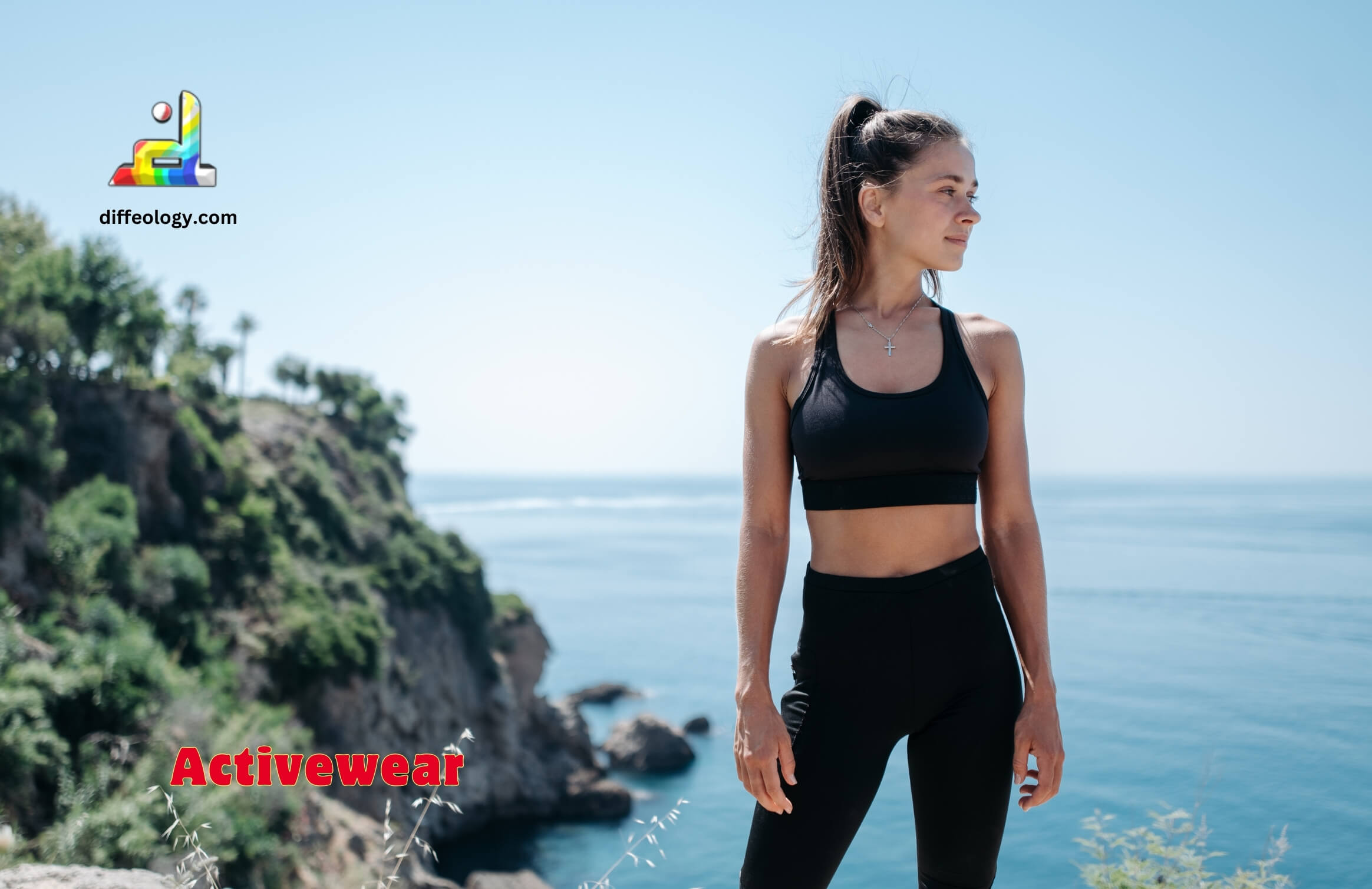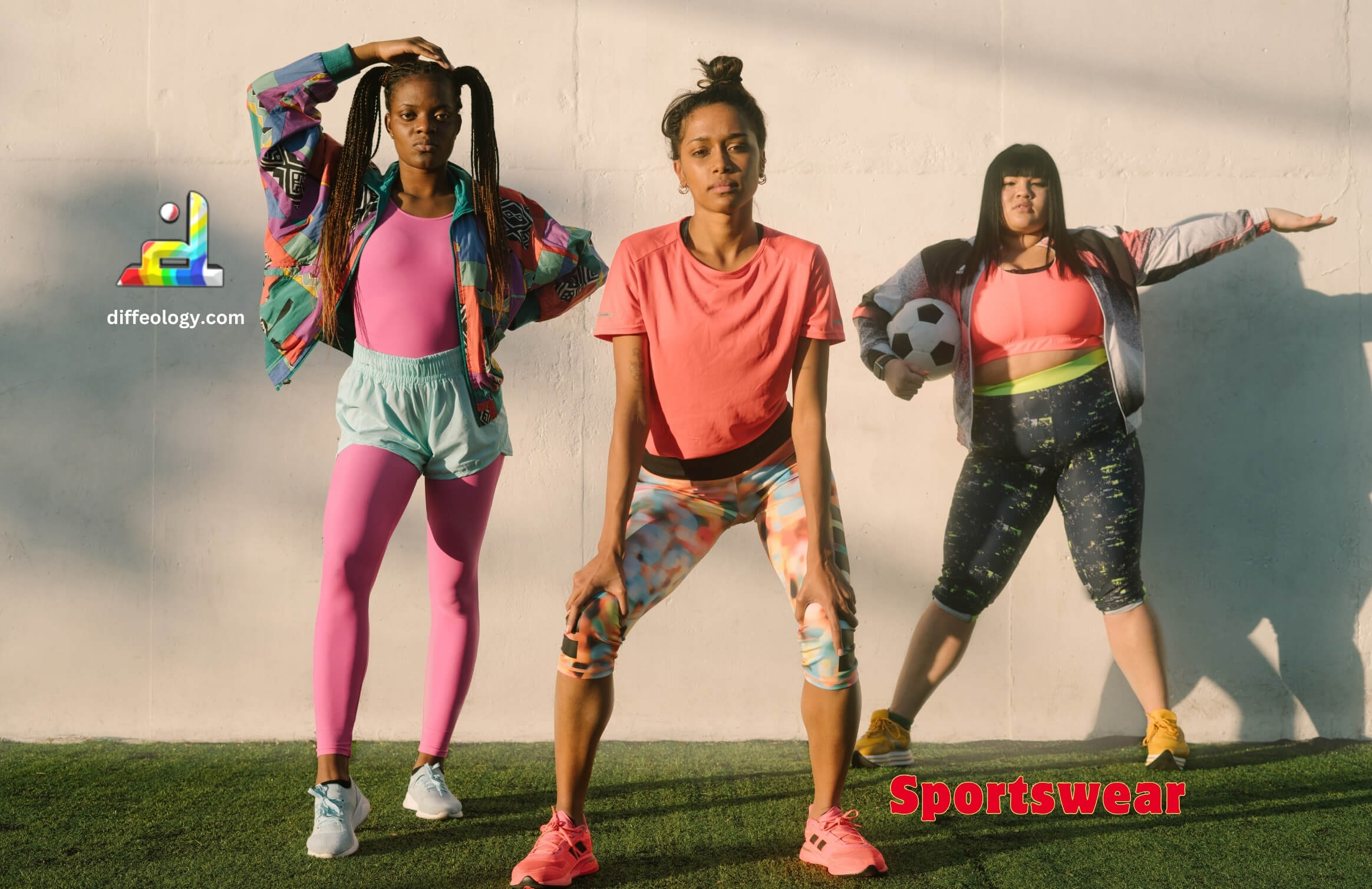When preparing for physical activities, the clothes you wear can significantly impact your performance and comfort. Two common types of clothing designed for exercise are activewear and sportswear, each serving distinct purposes. Activewear, such as yoga pants and comfortable tops, is not only suitable for sports but also for daily wear. In contrast, sportswear refers specifically to clothing and footwear tailored for particular sports, like tennis skirts or basketball jerseys. While both aim to enhance performance and comfort during physical activities, there is a huge Difference Between Activewear and Sportswear. Activewear emphasizes versatility and everyday use, while sportswear targets specific athletic needs.
Main Difference Between Activewear and Sportswear
Activewear refers to clothing designed for physical activity or exercise, often made with specialized fabrics to enhance comfort and performance. Sportswear includes attire specifically tailored for various sports and may encompass uniforms, shoes, and accessories. Activewear aims to provide flexibility and breathability, suitable for a wide range of activities from yoga to jogging. Sportswear is sport-specific, addressing the unique needs of particular sports such as basketball or tennis. Activewear commonly uses moisture-wicking materials like spandex or polyester blends to manage sweat and enhance movement. Sportswear fabrics vary widely, including durable polyester for soccer jerseys or lightweight nylon for running shorts.
Activewear Vs. Sportswear
What is Activewear?
Activewear is a type of clothing designed specifically for physical activities, sports, and exercise. This kind of clothing includes items like leggings, shorts, t-shirts, sports bras, and jackets. The key features of activewear are comfort, flexibility, and the ability to wick away sweat. These clothes are made from special materials that help keep you cool and dry while you are active. For example, many activewear items are made from polyester, spandex, or nylon, which are fabrics known for their durability and moisture-wicking properties.
Read Also: Difference Between Cotton and Cotton Blend
The popularity of activewear has grown significantly over the past decade. The global activewear market was valued at US$ 393.2 billion in 2023. Looking ahead, it is expected to reach US$ 627.3 billion by 2032, exhibiting a growth rate (CAGR) of 5.2% during the period from 2024 to 2032. Brands like Nike, Adidas, and Under Armour are well-known in the activewear industry. They continually innovate to create better, more efficient clothing that enhances athletic performance and comfort. Activewear has also become a fashion trend, with many people wearing these clothes not just for exercise but also for everyday activities.
What is Sportswear?
Sportswear refers to specialized clothing and footwear designed primarily for sports, exercise, and other physical activities. This category of clothing includes a variety of items such as T-shirts, shorts, leggings, tracksuits, sports bras, and athletic shoes. The main purpose of sportswear is to provide comfort, functionality, and performance enhancement during physical exertion. For instance, materials like polyester, spandex, and nylon are commonly used due to their moisture-wicking properties, which help keep athletes dry and cool.
Read Also: Difference Between Toboggan Hat and Beanie
The evolution of sportswear has been influenced by both fashion trends and technological advancements in fabric design. Initially developed for practical purposes, modern sportswear has become a global trend, with major brands like Nike and Adidas leading the market. The global sportswear market reached a value of nearly USD 313.22 billion in 20231. Looking ahead, it is projected to grow at a CAGR of 6.6% between 2024 and 2032, reaching around USD 558.14 billion by 2032. Sportswear continues to evolve with innovations that cater to various sports and fitness activities, emphasizing not only functionality but also style and comfort.
Comparison Table “Activewear Vs. Sportswear”
| Purpose | Designed for both exercise and casual wear. | Specifically designed for sports activities. |
| Fabric | Often uses moisture-wicking, flexible materials like spandex or polyester. | Includes durable fabrics like polyester or nylon for endurance. |
| Design | Stylish and trendy, it is suitable for various activities beyond sports. | Focuses on functionality and performance during sports. |
| Fit | Emphasizes comfort and flexibility, often with stretchy materials. | Tailored for specific movements and activities, ensuring mobility. |
| Examples | Yoga pants, leggings, and hoodies are designed for gym and everyday wear. | Jerseys, tracksuits, and compression shorts are designed for athletes and sports teams. |
| Versatility | Versatile for various activities and leisure. | Specific to sports activities, less versatile outside of athletic use. |
| Technology | Incorporates advanced fabric technologies for breathability and comfort. | Focuses on performance-enhancing features like moisture control and durability. |
| Fashion Influence | Influenced by current fashion trends, often seen in streetwear. | Less influenced by fashion trends prioritizes functional aspects. |
| Price Range | Wide range, from affordable to high-end designer brands. | Varies widely depending on brand and materials and often includes specialized gear. |
Difference Between Activewear and Sportswear in Detail
Purpose and Functionality
Activewear is designed for a wide range of physical activities, from yoga and gym workouts to running and hiking. It is versatile and often emphasizes comfort and style, allowing it to be worn for both exercise and casual daily activities. The materials used in activewear are usually lightweight, breathable, and moisture-wicking to keep you comfortable during various activities.
On the other hand, sportswear is specifically tailored for sports and competitive activities. Each piece of sportswear is crafted to meet the demands of specific sports, such as soccer, basketball, or tennis. The design and fabric are chosen to enhance performance, reduce injury risks, and provide maximum support and flexibility needed for that particular sport.
Fabric and Material
Activewear typically uses materials like spandex, nylon, and polyester, which provide stretch, durability, and breathability. These fabrics are excellent for managing sweat and ensuring comfort during physical activities. Additionally, many activewear items incorporate antimicrobial treatments to reduce odor.
Sportswear, however, focuses more on performance-enhancing materials that suit the sport’s specific needs. For instance, soccer jerseys often use lightweight, breathable fabric to keep players cool, while basketball uniforms might prioritize moisture-wicking and quick-drying capabilities. The choice of fabric in sportswear is crucial for optimizing athletic performance and comfort.
Style and Aesthetics
Activewear is known for its fashionable appeal. It often includes trendy designs, vibrant colors, and modern cuts that make it suitable for both the gym and casual outings. This dual-purpose nature means people can transition from a workout to running errands without changing clothes, which has popularized activewear in everyday fashion.
Sportswear, conversely, is more focused on functionality and team identity. The designs are often specific to the sport and include team logos, colors, and numbers. While sportswear can be stylish, its primary purpose is to enhance performance and represent a team or individual in a competitive setting, rather than to be worn casually.
Versatility
One of the hallmarks of activewear is its versatility. It is designed to be adaptable for various types of exercises and casual wear. Whether you’re hitting the gym, going for a jog, or just lounging at home, activewear suits many different scenarios, making it a convenient choice for a dynamic lifestyle.
Sportswear is generally less versatile because it is designed with a specific sport in mind. Each item is tailored to the requirements of that sport, such as the padding in football gear or the aerodynamic suits for swimmers. While sportswear excels in its intended environment, it might not be as comfortable or appropriate for other activities.
Durability
Activewear is built to withstand regular use and various types of physical activity. The fabrics used are durable and can handle frequent washing and wear. This durability makes activewear a practical choice for people who engage in multiple forms of exercise and need reliable, long-lasting clothing.
Sportswear, while also durable, is constructed to endure the rigors of competitive sports. This includes intense physical contact, frequent movement, and environmental conditions like rain or sun. For example, soccer cleats and football helmets are built to last through multiple games and practices, providing the necessary protection and performance.
Comfort and Fit
Activewear emphasizes comfort and a good fit to ensure freedom of movement and an enjoyable experience during any activity. The stretchy materials and ergonomic designs cater to a wide range of body types and preferences, making activewear comfortable for extended periods.
Sportswear is designed for optimal performance, which sometimes means a tighter or more structured fit. For example, compression garments are used in many sports to improve circulation and reduce muscle fatigue. While sportswear also prioritizes comfort, the fit is often more specific to enhance athletic performance and support the athlete’s needs.
Market and Trends
Activewear has become a significant trend in fashion, often referred to as “athleisure.” This trend combines athletic and leisurewear, making activewear a popular choice not only for workouts but also for everyday activities. The growing popularity of health and fitness culture has driven the demand for stylish and functional activewear.
Sportswear remains a staple in the athletic world, with its market driven by professional sports, amateur leagues, and recreational activities. Trends in sportswear often follow technological advancements that improve performance, such as new fabric technologies or innovative designs. The focus in sportswear is more on enhancing athletic performance and less on everyday fashion trends.
Key Points Presenting the Difference Between Activewear and Sportswear
- Design: Activewear often features trendy designs suitable for casual wear beyond exercise, blending fashion with functionality. Sportswear design prioritizes functionality, incorporating elements like padding in football uniforms or streamlined aerodynamics in cycling outfits.
- Versatility: Activewear is versatile, suitable for both gym sessions and everyday wear due to its comfort and style. Sportswear is typically specialized for performance during specific sports activities, with designs optimized for those purposes.
- Footwear: Activewear includes sneakers designed for comfort and support in various activities, from running shoes to cross-training sneakers. Sportswear footwear ranges from cleats for soccer or baseball to specialized court shoes for basketball.
- Layering: Activewear emphasizes layering options, allowing wearers to adapt to changing weather conditions or activity levels easily. Sportswear focuses on single-piece uniforms or outfits tailored to specific sports requirements.
- Fashion Trends: Activewear often follows current fashion trends with styles that can be worn beyond the gym, reflecting athleisure influences. Sportswear trends are more closely tied to the evolution of sports equipment and performance needs.
- Cost: Activewear can vary widely in cost, influenced by brand and fashion trends, catering to both budget-conscious shoppers and high-end markets. Sportswear prices are influenced by performance technologies and endorsement deals, often at higher price points.
- Durability: Activewear focuses on durability for repeated washings and diverse activities, ensuring longevity. Sportswear durability is tailored to withstand the rigors of specific sports, from abrasion-resistant fabrics in football uniforms to tear-resistant materials in wrestling singlets.
- Technology Integration: Activewear integrates tech features like built-in heart rate monitors or moisture sensors for enhanced performance tracking. Sportswear incorporates technological advancements like lightweight padding materials for safety and performance enhancement.
- Cultural Influence: Activewear is influenced by cultural shifts towards health and wellness, with designs reflecting global fashion trends. Sportswear design is often influenced by national or regional sports culture.
FAQs: Activewear Vs. Sportswear
Conclusion:
The Difference Between Activewear and Sportswear is simple. Activewear marketing emphasizes lifestyle and fashion appeal, targeting a broader consumer base beyond athletes. Sportswear marketing focuses on performance benefits and endorsements from professional athletes to highlight credibility and functionality. Activewear brands are widely accessible through online retailers, department stores, and specialty athletic shops, catering to a broad demographic. Sportswear availability can be more specialized, often sold through sports equipment stores or directly from manufacturers. Activewear innovations often come from collaborations between fashion designers and technology experts, leading to stylish yet functional designs. Sportswear innovation stems from sports science research and development, focusing on improving athlete performance and safety.
References & External Links
- What is Active wear Clothing? Things You Should Know
- Sportswear is clothing, worn for sport or physical exercise.



